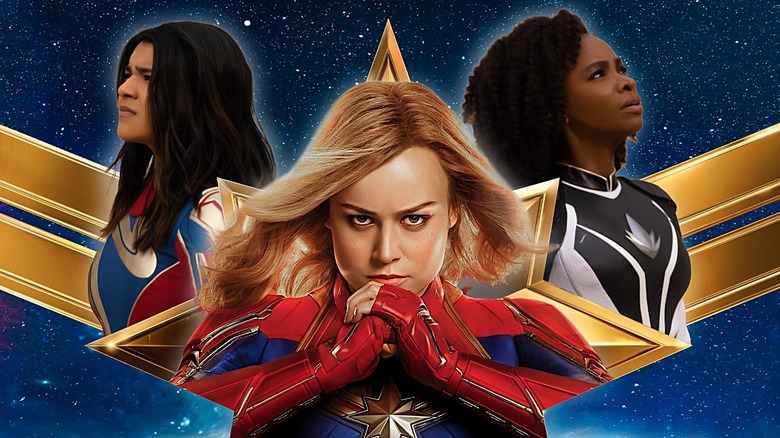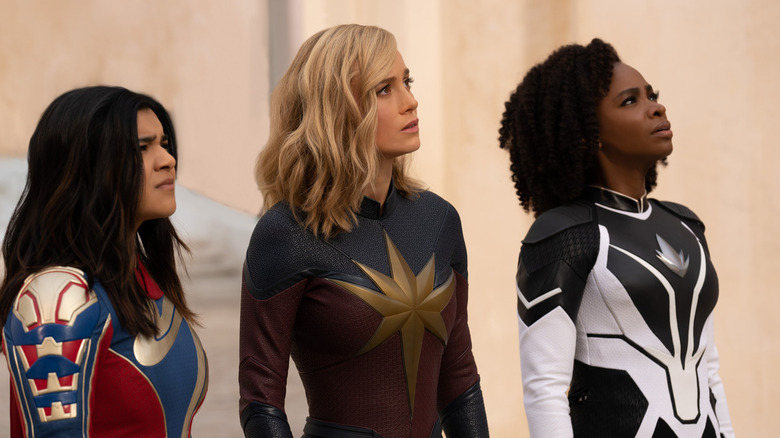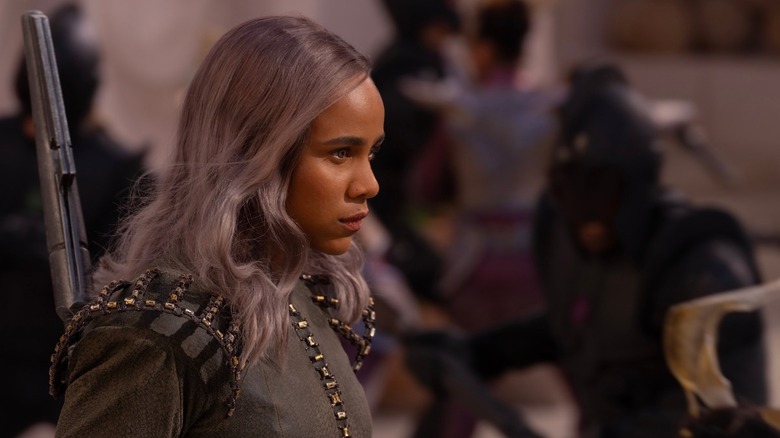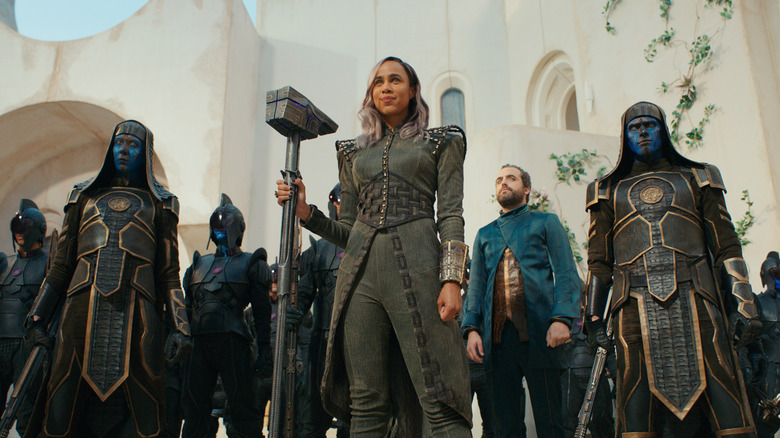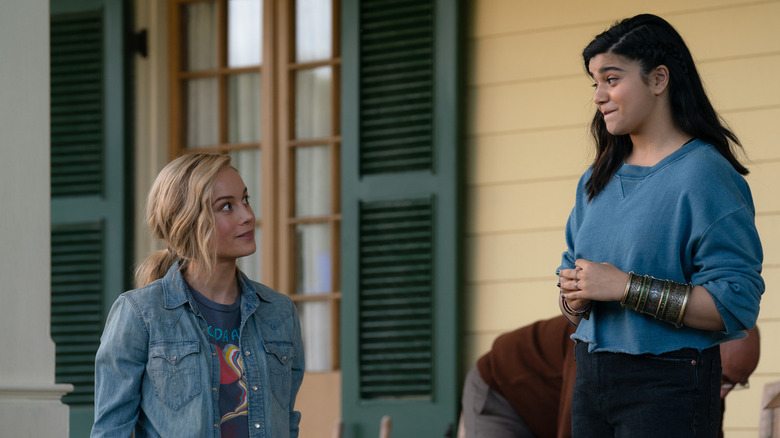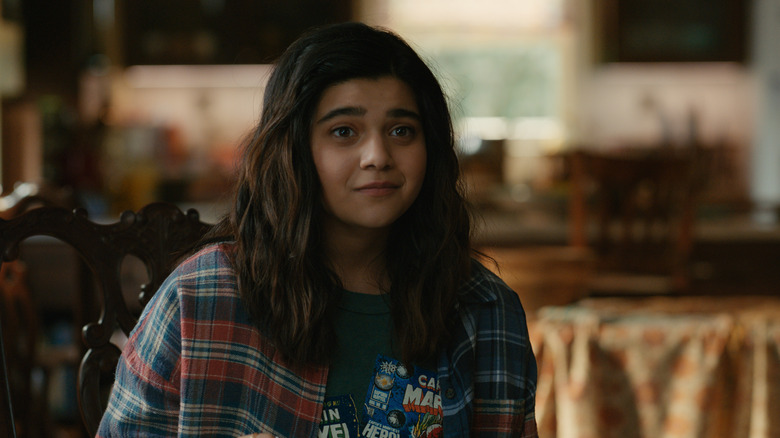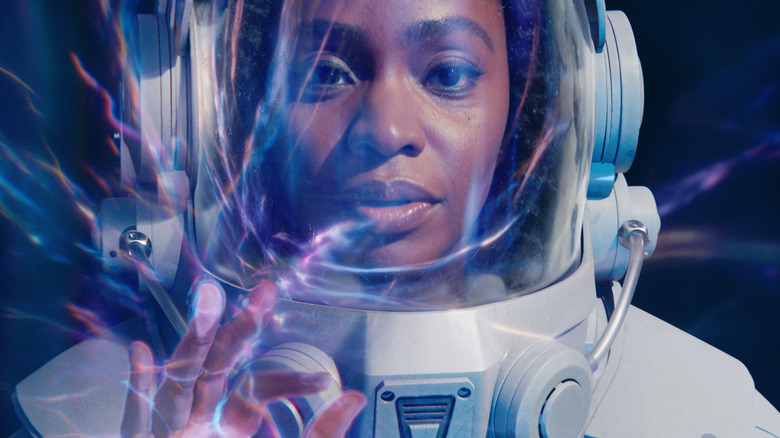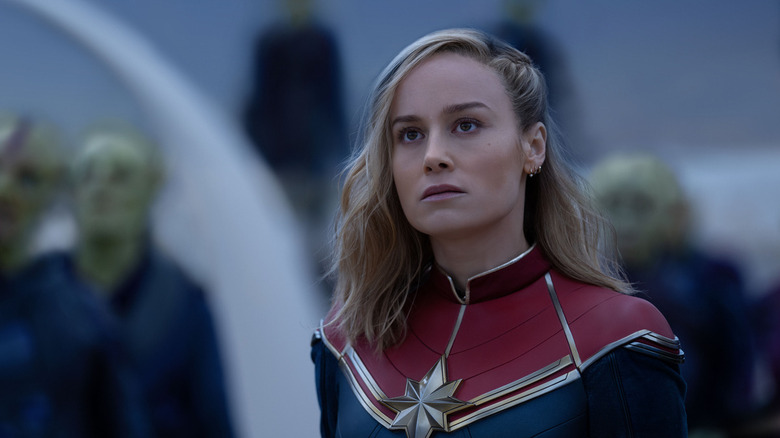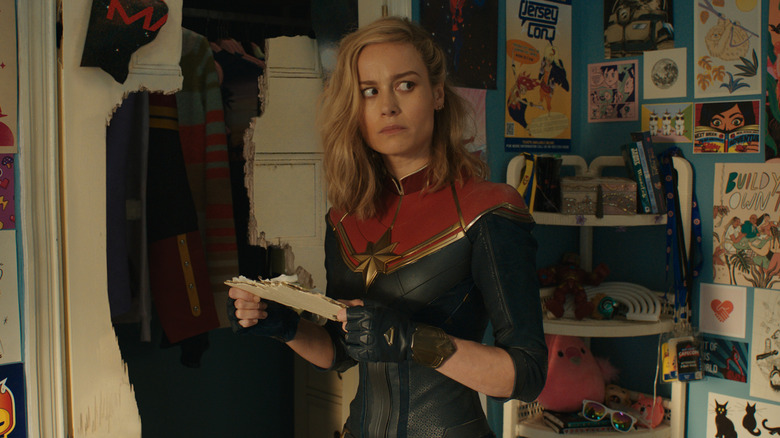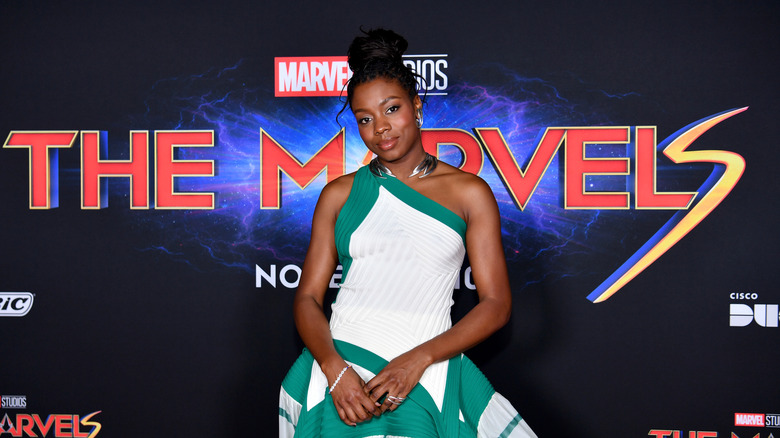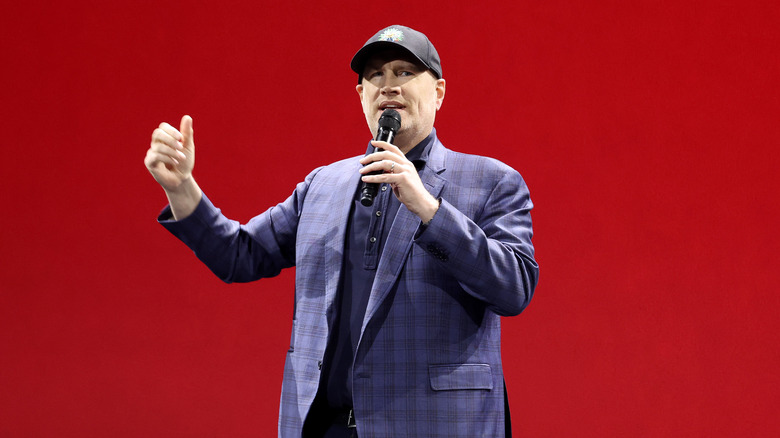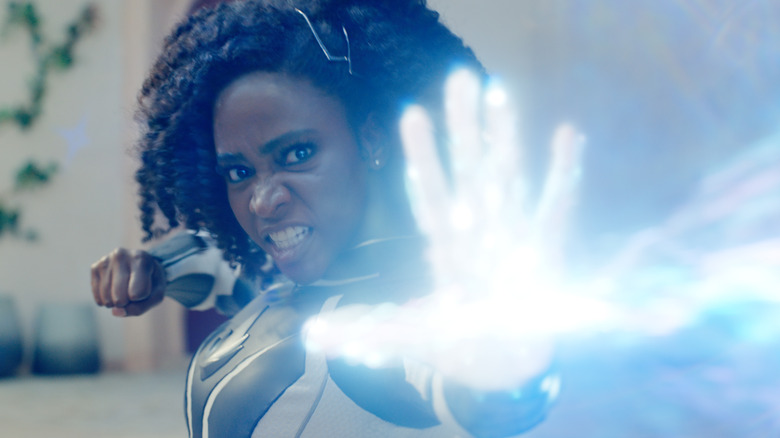The Ending Of The Marvels Explained
Like so many Marvel Cinematic Universe projects these days, "The Marvels" is many things. It's a sequel to 2019's "Captain Marvel," but one that makes Brie Larson's Carol Danvers just one of three superhero protagonists. In this way, it also becomes a sequel to "Ms. Marvel," which introduced Iman Vellani's Kamala Khan, and a sequel to "WandaVision," in which Teyonah Parris' Monica Rambeau first gets her superpowers.
Amid all these different connections — and the curious things it sets up by the end — "The Marvels" is just a fun action-adventure movie. The action is frenetic and creative, the locales are varied and colorful, and the tone is mostly light but emotional enough when needed. It's the kind of movie we used to get so many of back in the earlier phases of the MCU before every project became another puzzle piece in some larger story we might never see conclude.
Perhaps more than anything, "The Marvels" is a reminder that team-ups have always been the elevating factor for Marvel Studios. Though Phases 4 and 5 have delivered plenty of partnerships and cameos, "The Marvels" is the closest we've gotten to an actual Avengers movie since "Endgame." The chemistry between Vellani, Parris, and Larson is instantly palpable, and it carries the movie through a gloriously quick adventure that culminates in a strong finale. So let's dive a little deeper into the ending of "The Marvels" and what it could mean for the franchise's future.
What you need to remember about the plot of The Marvels
At the start of "The Marvels," our three leads are in very different places — both emotionally and physically. Kamala is riding high off of her heroic ascent at the end of "Ms. Marvel," drawing fresh fan art of herself and Captain Marvel in her Jersey City bedroom. Monica is investigating a strange energy phenomenon aboard the S.A.B.E.R. space station orbiting Earth, and Carol is, as usual, alone — riding through the empty blackness of the cosmos with no one but Goose at her side.
After the Kree warrior, Dar-Benn (Zawe Ashton) — a successor to Ronan the Accuser (Lee Pace) — locates a powerful bangle just like Kamala's, she begins tearing holes in space-time to restore the Kree homeworld of Hala to glory. This causes the three heroes' abilities to become entangled, meaning that whenever two of them power up at the same time, they swap places.
The ensuing chaos brings Kamala face-to-face with her idol and Monica face-to-face with the aunt who abandoned her. Together, they try to stop Dar-Benn from stealing various planets' resources, failing to protect the Skrulls on Tarnax and the musical people of Aladna. They do manage to confront some of their own demons, however, preparing them for a showdown with Dar-Benn on Earth. As her crowning move, she aims to steal Kamala's bangle and use the amplified power to take our sun. But she has to get through the Marvels first.
What happens at the end of The Marvels
As Dar-Benn begins her attack over Earth, the S.A.B.E.R. station starts to destabilize. But with many core systems already knocked out, there aren't enough escape pods to get everyone to safety. Thankfully, Goose comes in clutch by birthing a horde of Flerken kittens about the station. When the Marvels arrive, they help Nick Fury (Samuel L. Jackson) chase down all the S.A.B.E.R. folks so that the Flerkens can gobble them up. This stores them in the kitties' void-like tummies, effectively shrinking the population of the station and allowing them to fit (inside the cats) in the remaining pods. It's a bizarre and hilarious sequence set aptly to "Memory" from the musical, "Cats," but rest assured, everyone is regurgitated safely on the ground.
Meanwhile, Kamala, Carol, and Monica face off against Dar-Benn. They defeat her, and Carol agrees to a tentative peace. She promises to use her powers to restore Hala's sun, undoing the damage unintentionally wrought by her destruction of the Supreme Intelligence in "Captain Marvel." Of course, Dar-Benn double-crosses them, steals Kamala's bangle, and launches herself into the void. With both "quantum bands," Dar-Benn rips a hole in space-time clean through to an alternate reality, vaporizing herself in the process. Carol retrieves the bangles, gives them both to Kamala and together, they power up Monica enough that she can fly to the other side of the hole and close it. Tragically, though, she's trapped there, as Carol can't save her in time.
Healing Hala
With Earth saved, Dar-Benn defeated, and Monica lost in some strange unknown, Carol decides to finally settle her battle with the Kree. She returns to Hala, where the dying sun barely lights the sky anymore. Then, in a staggering display of her power, she flies straight through the star, energizing its core reactions with her energy and reviving it to its bright, glowing glory. The Annihilator, as the Kree calls her throughout the movie, becomes the savior of the entire race.
For Captain Marvel, this is a big deal. She reveals throughout the film that her conflict with the Kree still largely defines her life. The violence they committed against her — stripping her of her memories and turning her into a weapon — alienated her from everyone she once knew as family. At the same time, her vengeance against them only led to more violence, as the entire world of Hala fell into a quick decline.
By repairing Hala's sun, Carol shows that she can be a force for creation as well as destruction. This closure, combined with her experiences with Kamala and Monica, finally allows her to move on and return home to Earth. This could also finally mark the end of the longstanding Kree-Skrull conflict. The movie suggests that both species are finally ready to invest in peace, and the healing of Hala might be all the Kree needed to give up on their evil crusade at last.
Going home
With her Kree chapter finally closed, Carol goes home. Or, rather, she goes to a new home, but one that's very familiar. We see the Kahn family help her move into Maria (Lashana Lynch) and Monica Rambeau's old house in Louisiana, complete with the little airplane. Dressed in regular Earth attire, Carol finally seems ready to stop moving around for a little bit.
Throughout the movie, we learn how much guilt she carries from her time with and fighting the Kree. But now that she's made peace with that part of her past, she decides to stop running. Parallel lines show that Carol has developed a similar affection for Kamala that she has for Monica. Not only has she accepted a permanent home, now, but she's accepted her place in a larger family as well.
Of course, she has an ulterior motive in moving into the old Rambeau house. As she tells Kamala, she's just taking care of it while she waits for Monica to "get back." She has no idea where Monica could be or whether she'll ever return, but that doesn't dissuade her from staying. Captain Marvel's time eschewing personal relationships is over. Even with Monica gone, she's not going to abandon her again. In another scene on the S.A.B.E.R. station, we see that Fury misses her too.
A new team
The final scene of "The Marvels" takes place in New York City, where Kamala confronts none other than Kate Bishop (Hailee Steinfeld). The whole thing plays like a spoof of the Nick Fury scenes from the early MCU. Kate comes home to find Kamala sitting in an armchair, cloaked in darkness.
Kamala puts on her best Fury impression, but it quickly gives way to her own fast-talking, quirky persona. She tells Kate that she's putting together a team, which, at the moment, is just the two of them (provided Kate accepts). She assures her, though, that she has "feelers" out there, mentioning Ant-Man's daughter Cassie Lang (Kathryn Newton) specifically. Despite the somewhat clumsy proposal, Kate smiles, suggesting that she's down for the team-up.
This seems like an obvious setup for the oft-theorized "Young Avengers" movie. The MCU has introduced a ton of new heroes in Phase 4 and Phase 5, including Kamala, Kate, Cassie, Yelena Belova (Florence Pugh), Riri Williams (Dominique Thorne), and Joaquín Torres (Danny Ramirez). Any combination of these characters and others could form a new superhero team, and the ending of "The Marvels" seems to set that up perfectly.
What happens in the mid-credits scene of The Marvels?
There's only one credits scene in "The Marvels," positioned between the first round of main credits and the standard credits that come after. In it, we see Monica awaken in some kind of medical facility, groggy but alive after her cosmic outing. She turns and sees none other than her own mother sitting at her bedside — albeit a pretty young version of her.
When Monica calls Maria "Mom," the older woman looks at her strangely, suggesting that she's never seen Monica before. Then, everything gets turned on its head when Kelsey Grammer's Hank McCoy, aka Beast, walks into frame — fully blue, furry, and dressed in a lab coat.
Outside the glass walls of the medical room, we can see the iconic round "X" doorway from the X-Men movies. This and Grammer's presence both suggest that we are in some version of the Fox X-Men universe, as Grammer played Beast all the way back in 2006's "X-Men: The Last Stand." He mentions that "Charles" will want an update on their guest, and in the last shot, we see Maria's new superhero costume: a red jumpsuit that evokes the comic book character Binary. Binary has a strange and powerful connection to Carol Danvers in the Marvel comics, in that the two are the same person (kind of — it's complicated). It should be interesting to see how this new version of the character plays into the MCU's X-Men storyline.
What does the ending of The Marvels mean?
The ending of "The Marvels" is more about the action beats and future setups than it is about larger themes or ideas. But that's not to say that the film is devoid of meaning — quite the contrary. By the end, the biggest resounding theme — as it is in so many modern blockbusters — is the importance of family, be it born or found.
All three main characters have arcs relating to family. At the beginning of the movie, Carol has cut herself off from all forms of family. She carries so much shame and guilt that she believes she deserves to be lonely, and she's scared of getting close to anyone again because of the fear that she'll lose them. Of course, in the end, it's her reunion with Monica and her new relationship with Kamala that allows her to heal.
Monica, likewise, has built a wall of professionalism around herself, resentful of Carol and scared to get close to anyone after the death of her mother. In the end, she saves the entire world (and possibly the universe?) because she trusts the other two Marvels. Kamala is the only one of the three who already has a strong family, and we see just how much that empowers her. Though her mother is always scared for her, she ultimately accepts that Kamala is destined for "something greater." She encourages her daughter to be a hero but also reminds her that she'll never "let her go."
No one heals alone
"The Marvels" isn't really "Captain Marvel 2," but it does give more closure to Carol's story than it does to Kamala's or Monica's. The latter is now stuck in a whole new reality, and the former is just beginning what's hopefully a long and successful superhero career. Carol doesn't retire by any means at the end of the movie, but she does wrap up the arc that began back in the first "Captain Marvel."
For decades, Carol tried to repair her memories and reclaim her life, but she did so alone in the cold vacuum of space. It's clear she viewed this as penance — dues to pay for the harm she's inflicted — but she can't heal properly until she lets people back into her life. At one point Kamala tells Carol that she made a tough call because that's what Carol would have done. "You shouldn't try to be like me," Carol says in response, full of self-loathing.
Maybe it's reconciling with Monica that gets her over that hump, or it's Kamala's unabashed reverence for her. Perhaps it's the realization that she can use her powers to heal. Really, it's a combination of all those things that allows Carol to finally forgive herself.
What has the cast and crew said about the ending of The Marvels?
Due to the SAG-AFTRA strike of 2023, the cast of "The Marvels" hasn't been as active in promotion as is typical of such a big movie. However, the leads did conduct interviews prior to the strike that were included in official press materials.
Speaking of her own character's journey in the film, Brie Larson said, "It's a tough one for Carol because she's sort of decided to work alone because it's too painful to try and deal with loss." In the movie, it's clear that Carol is frustrated with the entanglement at first, but when it goes away at the end of "The Marvels," she's visibly sad. When they're entangled, she has an excuse to stay near other people. Without it, she's left to her own devices, but thankfully, she chooses to stay in community instead of isolating yet again.
"I really wanted to make family the theme," director Nia DaCosta said in an interview with io9. "I really wanted to ground the film emotionally inside of that framework — so the Khan family is a huge part of the movie and they are sort of a representation of what Monica and Carol could have had or what they once had." Discussing the final act of "The Marvels," DaCosta said, "I think where we leave all these characters is really exciting and it really points to what's next in a way that I love. And I think fans of the MCU are really gonna enjoy that."
What has Kevin Feige said about the ending of The Marvels?
Marvel Studio head Kevin Feige has also said some interesting things about the ending of "The Marvels" — specifically, how it sets up the return of the X-Men in the MCU. Asked on "The Marvels" red carpet by Entertainment Tonight about rumors of an X-Men cameo, Feige was coy, but he did acknowledge that fans might not have long to wait. "In live action, people will see — perhaps soon," the MCU chief said.
Mostly, Feige talked around the X-Men's role in the film, as the interview was conducted before the movie's wide release. He was, however, very excited about the notion of finally bringing the beloved characters into the franchise. "It's super exciting," Feige said. "But the X-Men are as solid and rich and great a concept and characters as exist. The return of the animated series next year, which we're very excited about. I saw some new final episodes today, which really bring you back to that core of who the X-Men are and that soap opera that those characters represent."
Even with Kelsey Grammer's Beast and the old X-Man headquarters popping up at the end of "The Marvels," we don't know what role they'll play or how they'll be incorporated. Those questions will likely be answered in more detail when the highly anticipated "Deadpool 3" finally comes out.
What does the ending of The Marvels mean for the MCU?
As fun as "The Marvels" is on its own merits, many fans will likely be even more excited by the future projects it may be setting up. The biggest of those is the long-awaited MCU version of the X-Men. Most likely, Marvel Studios will want to make its own X-Men movies, but the story could also take place (at least in part) on Disney+. The slow rollout of these new X-Men has confused things a bit as well. We got Patrick Stewart back as Charles Xavier in "Doctor Strange in the Multiverse of Madness," Kelsey Grammer's Beast appears in "The Marvels," and Hugh Jackman is set to return as Wolverine in "Deadpool 3." But as long as the multiverse era of the MCU continues, there's no way to know how important those actors will remain. Disney would probably want to fully recast the X-Men for a new generation. For now, fans will have to keep waiting.
The other big thing set up in "The Marvels" is the potential "Young Avengers" project, or whatever the team that Kamala Khan and Kate Bishop are forming will be called. Embracing the franchise's younger heroes could be a great way to softly reset the MCU, but that's also a big risk.
The one thing that "The Marvels" doesn't clearly set up is a "Captain Marvel 3." But that doesn't mean that it won't happen. Carol Danvers is back on Earth now, so she could be pulled into any number of upcoming stories. Plus, her new Louisiana home places her in close proximity to Sam Wilson (Anthony Mackie) and his family, who also reside in the state. Perhaps we'll get a Captain Marvel cameo in "Captain America: New World Order."
